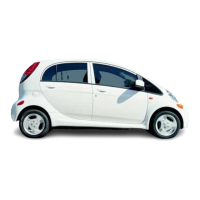ABS <4WD> -
Service Specifications/Special Tools/Troubleshooting
35B-4
SERVICE SPECIFICATIONS
Item Standard value
Control solenoid valve resistance W
IN 4.75 - 5.25
OUT 2.0 - 2.4
Select solenoid valve resistance W 3.5 - 3.9
Wheel speed sensor terminal resistance kW 1.0 - 1.5
Wheel speed sensor insulation resistance kW 100 or more
SPECIAL TOOLS
Tools No. Name Application
MB991502 MUT-II sub as-
sembly
Checking the ABS
(Diagnosis display using the MUT-II)
MB991529 Diagnosis code
checking harness
Checking the ABS
(Diagnosis display using the ABS warning
lamp)
MB991348 Test harness set Checking the G sensor
TROUBLESHOOTING
STANDARD FLOW OF DIAGNOSTIC TROUBLESHOOTING
Refer to GROUP 00 - How to Use Troubleshooting/Inspection Service Points.
PRECAUTIONS WHEN CARRYING OUT DIAGNOSIS
(1) The ABS is a system which controls the brake pressure by means of th e operation of th e ECU.
Accordingly, the following symptoms may occur at times, but these are a sign of normal ABS operation,
and do not indicate a malfunction.
Symptom Explanation of symptom
When the engine starts, a knocking sound can be heard coming from
the engine compartment.
This sound occurs as a result of system
operation checking, and is not a
malfunction.
1. The brake pedal feeling changes and noise is generated.(Rattling)
2. When the ABS is operating, noise is generated by parts of the
vehicle chassis as control turns on and off. (Thump: suspension;
squeak: tyres)
This is the sound of normal system
operation, and is not a malfunction.
Shocks are felt if the brake pedal is depressed when driving at low
speed.
This is due to system operation
checking (starting- of check when the
vehicle speed reaches a certain
number of km/h) and is not a
malfunction.
www.WorkshopManuals.co.uk
Purchased from www.WorkshopManuals.co.uk

